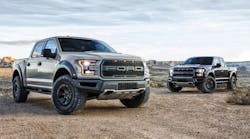Ford Motor Co. CEO Jim Hackett has already called 2018 a “bad year,” casting some of the blame on costlier raw materials used to build cars.
It’s an excuse that’s both valid and not the whole story for Ford, which reports quarterly earnings after the close on Jan. 24. Rising prices for steel, aluminum and other metals are exacerbating issues including the automaker’s outsized reliance on its popular F-Series pickup line that’s facing new competitive pressures.
Investors apparently agree with the CEO’s assessment. They’ve traded down Ford’s shares nearly 9% since executives warned last week that profit will drop this year. The second-largest U.S. automaker is projecting a $1.6 billion headwind related to raw materials and exchange rates in 2018, following a $2 billion drag on 2017 results.
“The changes in commodity prices and exchange rates that we’ve seen over the last several years have had a material effect on the business,” CFO Bob Shanks told analysts Jan. 16 at a Deutsche Bank conference in Detroit. “We see that continuing in 2018.”
The price of steel, Ford’s biggest commodity purchase, has spiked 18% since the start of last year. Aluminum, used for the bodies of F-Series trucks, is up by nearly a third.
Still, rival General Motors Co. executives didn’t discuss commodity costs when forecasting earnings will be steady this year, despite an expensive factory changeover to produce new pickups. That’s left some analysts questioning if competitive threats to Ford’s “precious” truck line could also be playing a factor in its outlook.
Truck Risks
“We think the disappointing guidance is only partially explained” by rising raw materials prices and other non-surprising costs, Barclays analyst Brian Johnson wrote in a Jan. 17 report. Ford’s outlook also may reflect “pressures in its large pickup profitability as GM and Ram roll out new platforms over the next two years.”
Ford earns much of its profit from F-Series, the top-selling vehicle in America since the Reagan administration. GM unveiled its redesigned Chevy Silverado and Fiat Chrysler Automobiles NV introduced a new Ram 1500 at last week’s Detroit auto show, aiming them squarely at Ford’s stronghold on the lucrative big pickup segment.
Ford is fighting back by introducing a new diesel engine in the F-150 and expanding its truck lineup by bringing back the mid-size Ranger that it pulled from the U.S. market in 2011. But those efforts won’t keep profit from falling this year. The cost of developing self-driving cars and electric vehicles also is weighing on Ford’s bottom line.
“Ford can’t seem to overcome the headwinds, perhaps indicating weaker product cadence versus GM, and headwinds around its commodity strategy,” Johnson wrote.
Steel Surge
The raw material that hit Ford hardest last year was steel, and that’s likely to be the case again this year, Shanks said. Although the carmaker has multiple steel-supply contracts that are phased in overtime to help smooth prices, he said the market isn’t robust enough to formally hedge against volatile prices.
Prices have been surging as President Donald Trump considers imposing tariffs on steel imports. Trump, who announced tariffs on Jan. 22 on solar equipment made outside the U.S., received a final report from the Commerce Department earlier this month on whether foreign steel shipments are harming U.S. national security and have 90 days to respond.
Aluminum Impact
Aluminum is next on Ford’s raw materials purchase list since the automaker has significantly increased its use of the lightweight metal to improve fuel efficiency. Besides outfitting the F-Series in aluminum, Ford also uses the light metal for the bodies of its large sport utility vehicles, the Expedition and Lincoln Navigator.
The White House is considering implementing tariffs on aluminum as well. Prices have also been buoyed by reports China has been shutting down some of its smelting overcapacity as part of a broader pollution-fighting initiative.
Earnings Expectation
With costs on the rise, Ford is expected to post a fourth-quarter adjusted profit of 39 cents a share, according to a Bloomberg survey of 10 analysts. That would be up from 30 cents a share a year ago but below earlier expectations.
The U.S. automaker reported preliminary adjusted earnings of about $1.78 a share for 2017 and said profit on that basis will slip between $1.45 and $1.70 this year. While Wall Street had been expecting a drop, the low end of that range is worse than what analysts were anticipating.
“The transition at Ford in the Hackett era will take time,” Johnson wrote, citing a long road ahead for the automaker. “It doesn’t seem as if there are any low hanging fruits on cost to drive upside to earnings.”
By Keith Naughton and Joe Deaux




